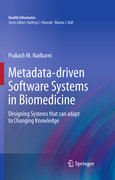
Metadata-driven software systems in biomedicine: designing systems that can adapt to changing knowledge
Nadkarni, Prakash M.
While the use of database technology is ubiquitous throughout IT (and health IT in particular), it is not generally appreciated that, as a database increases in scope, certain designs are far superior to others. In biomedical domains, new knowledge is being generated continually, and the databases that must support areas such as clinical care and research must also be able to evolve while requiring minimal or no logical. physical redesign. Appropriately designed metadata, and software designed to utilize it effectively, can provide significant insulation against change. Many of the larger EMR or clinical research database vendors have realized this, but their designs are proprietary and not described in the literature. Consequently, numerous misconceptions abound amongindividuals who have not had to work with large-scale biomedical systems, andgraduates of a health or bioinformatics program may find that they need to unlearn what they were taught in database and software design classes in order to work productively with such systems. A working knowledge of such systems is also important for individuals who are not primarily software developers, suchas health informaticians, medical information officers and data analysts. This book is, in a sense, intended to prepare all of the above individuals for the real world. INDICE: 1. What is metadata? Types of metadata. Descriptive (interpreted by humans). Technical (utilized by software). Some metadata shows characteristics of both. How metadata is represented. Why use metadata to build biomedical systems? Caveat: Metadata-driven systems are initially harder to build, Building for change: flexibility and maintainability, Elimination of repetitious coding tasks, Case Study: Table-driven approaches to software design. 2. Metadatafor supporting electronic medical records. The Entity-Attribute-Value (EAV) data model:. Why EAV is problematic without metadata-editing capabilities: the TMR experience. Pros and Cons of EAV: When not to use EAV. How metadata allowsad hoc query to be data-model agnostic. Transactional operations vs. warehousing operations. Case Study: The I2B2 clinical data warehouse model. Providing end-user customizability, Case Study: EpicCare Flowsheets. 3. Metadata for clinical study data management systems (CSDMS). Critical differences between an EMR and a CSDMS. Essential elements of a CSDMS. HTML-based vs. non-Web interfaces: pros and cons. Case Study: Metadata for robust interactive data validation. Metadata and the support of basic bioscience research. Object dictionaries and synonyms: the NCBI Entrez approach. Fundamentals of object-oriented modeling: the use of classes. Case study: representing neuroscience data: SenseLab. Case study: managing phenotype data. 4. Descriptive Metadata: Controlled Biomedical Terminologies. Classification of Controlled Vocabularies, with examples: Collections of Terms, Taxonomies: a hierarchical structure, Thesauri: Conceptsvs. Terms, Ontologies: Classes and Properties, Cimino’s criteria for a good controlled vocabulary, Fundamentals of Description Logics, Pre-coordination vs.compositional approaches to new concept definition, Challenges when the set of permissible operations is incomplete, Difficulties in end-user employment oflarge vocabularies, The use of vocabulary subsets: the 95/5 problem, Case Study: the SNOMED vocabulary. 5. Metadata and XML. Introduction to XML. Strengthsof XML for information interchange. Misconceptions and common pitfalls in XMLuse. Weaknesses of XML as the basis for data modeling. The Microarray Gene Expression Data (MGED) experience. Use of the Unified Modeling Language. UML is intended for human visualization. UML has an internal XML equivalent (XMI). Case Study: Clinical text markup. 6. Metadata and the modeling of ontologies. Ontology modeling tools: Protégé. Common Pitfalls in Ontology Modeling. Scalableontology designs. Supporting reasoning in ontologies: classification. An introduction to Semantic Web technologies. Limitations: the open-world assumption.Case Study: Implementing constraints in SNOMED. 7. Metadata and Production-Rule Engines. Introduction to Production-Rule Systems. Strengths and weaknesses of rule frameworks. Embedded rule engines. Data that can be executed as code:
- ISBN: 978-0-85729-509-5
- Editorial: Springer London
- Encuadernacion: Cartoné
- Páginas: 336
- Fecha Publicación: 29/05/2011
- Nº Volúmenes: 1
- Idioma: Inglés
